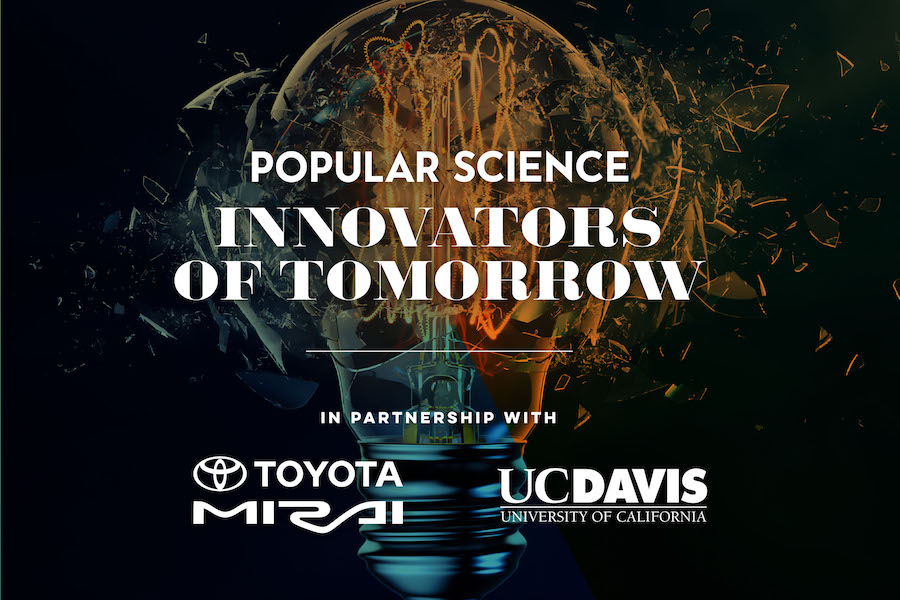
PopSci, UC Davis, Toyota work together to host innovation event
Innovation arises from all sources of inspiration, regardless of a person’s age, background or specialty. Popular Science hosted the Innovators of Tomorrow event on Nov. 9 at the Mondavi Center at UC Davis, where the creative ideas of two high school students were showcased. Afterward, there was a short panel regarding the future of innovation, as well as a discussion of how to hand down important skills to the next set of students and thinkers. The event was streamed on Facebook and drew in 8,000 viewers.
$10,000 scholarships were also presented to high school seniors Jade Woods and Ann Nguyen from Saint Joseph’s Academy in Baton Rouge, La. for providing their ideas to combat concussions and coastal erosion. Woods’ plan involves creating glasses that can accurately detect eye injuries so that concussions, which are most common in athletic injuries, can be detected faster. Nguyen wants to battle coastal erosion with “nanograss,” which may mimic the natural processes of seagrass and help be a “natural barrier” to coastal erosion. Both Woods and Nguyen visited California for the first time to present their ideas, and the judges had not noticed they were from the same AP Physics class.
According to Corinne Iozzio, the managing editor at Popular Science, a complicated procedure isn’t necessary to solving a problem, as Woods and Nguyen demonstrated in their projects.
“It’s really just about not overthinking things as often,” Iozzio said. “A simple, elegant solution might not seem as impressive in a schematic diagram, but if you can do something with a dollar instead of a hundred dollars, that’s a really big deal.”
Following the presentations, Iozzio hosted a panel with UC Davis Chancellor Gary S. May, Jackie Birdsall, a senior engineer at Toyota and Ross Fabini, the founder of XYZ Ventures. Key aspects of the discussion included the value of mentorship in self-growth, the need of diversity to drive innovation, and the importance of bouncing back after every failure.
“I think everyone has experienced failure at some level, and my advice is to fail quickly and learn from the failure,” May said. “You’re going to fail, and the vast majority of startups fail. The people who have been successful have failed multiple times before they’ve hit the big success. So what is common among them is the perseverance to keep going, to solve that next problem, and the willingness to learn from that failure and improve the next times.”
The event was also sponsored by Toyota, and Birdsall shared her views on how to turn an idea into a physical product.
“There are maybe three ways that, personally, I found you can break down an idea and see if you can make it into reality,” Birdsall said. “And the first step is to confirm the need. [For example, with the Toyota Mirai […] about 20 years ago, Toyota Management saw that burning gasoline in the internal engine was not a sustainable option for transportation, and so we had a need to move toward zero emission vehicle technology, so 20 years ago — well I recently joined 10 years ago — to bring out the Toyota Mirai. Similarly, we’ve seen demonstrations from these two innovators today [Woods and Nguyen] where they’ve identified a need, confirmed that there’s a gap that needed to be filled, so that’s kind of the first step of an idea — the need. The second is to vet it. I’ve always found it very helpful to find someone that is smarter and wiser than myself, and take my idea to them and really vet it through them. And the third is my personally favorite aspect of generating an idea, as an engineer, and that’s experimenting.”
The Toyota Mirai is one of the first commercial vehicles vehicles that is powered by a hydrogen fuel cell, initially released in 2015, with its most recent iteration released earlier this year.
“It’s an all-electric vehicle, but instead of plugging in, you refill it with hydrogen,” Birdsall said. “It takes about 3 to 5 minutes to refill, and it goes 300 miles on a fill. Instead of storing the electricity in the battery, like a battery-electric vehicle, we’re creating the electricity real time.”
As the driver steps on the accelerator pedal, the hydrogen tanks, which are mostly located in the trunk, release hydrogen, which combine with oxygen. It is one of the simplest chemical reactions, where oxygen and hydrogen form water, resulting in a byproduct of heat and energy used to power the vehicle. Because of the abundance of hydrogen, this type of energy productive is more environmentally friendly than internal combustion engines, and hydrogen fueled cars are not limited by how much energy can be converted into motive power.
Such innovations are driven by having diversity in the workplace, whether it’s people from different backgrounds, cultures, ages, genders and field of study. An important aspect of advancement is mentorship.
“I see this a lot, even if I just think about my own experiences with editors who are senior to me,” Iozzio said. “One of the most valuable things that a mentor can do is push you out of your comfort zone. Not just push you off the cliff, but be there with you while you work your way through the process.”
Written By: Jack Carrillo Concordia — science@theaggie.org



